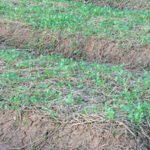Is brown pressure treated wood safe for vegetable gardens? This is a common question among gardening enthusiasts who are considering using pressure treated wood in their outdoor projects. Pressure treated wood is a popular choice for building garden beds and raised planters due to its resistance to decay and insects. However, there are concerns about the chemicals used in the treatment process and their potential impact on soil and plants.
Pressure treated wood is created through a process that involves injecting chemicals into the wood under high pressure. This enhances the wood’s durability and makes it suitable for use in outdoor settings where it may be exposed to moisture and pests. The chemicals used in this process raise questions about whether brown pressure treated wood is safe for growing vegetables and other edible plants.
In this article, we will explore the controversy surrounding the use of brown pressure treated wood in vegetable gardens. We will discuss the process of pressure treating wood, examine the chemicals involved, address safety concerns, and provide alternative options for garden construction.
Additionally, we will delve into regulations and certifications governing the use of pressure treated wood in garden beds, as well as best practices for using it responsibly. Whether you are an experienced gardener or new to vegetable gardening, understanding the potential risks and benefits of using brown pressure treated wood is essential for making informed decisions about your garden projects.
What Is Pressure Treated Wood
The Process of Pressure Treating Wood
Pressure treated wood is created through a process that involves placing the wood in a pressurized chamber, where it is then infused with chemical preservatives. This process helps protect the wood from decay, rot, and insect damage, making it more durable and long-lasting than untreated wood. The most common method of pressure treatment involves using chemicals such as chromated copper arsenate (CCA), alkaline copper quaternary (ACQ), or copper azole.
How It Differs From Natural Wood
Natural wood, when used in outdoor settings such as garden beds and raised planters, is susceptible to moisture-related issues such as rotting and decay. Pressure treated wood, on the other hand, has been specially treated to withstand these challenges, making it a popular choice for outdoor construction projects. However, the use of chemical preservatives in pressure treated wood raises concerns about its safety for use in vegetable gardens.
Potential Environmental Impact
While pressure treated wood is effective in protecting against decay and insect damage, there are potential environmental concerns associated with its use. The chemicals used in pressure treatment have the potential to leach into the surrounding soil over time, impacting plant growth and potentially harming beneficial organisms in the ecosystem.
Additionally, there is debate about the long-term impact of these chemicals on human health when vegetables grown in contact with pressure treated wood are consumed. This has led to some controversy over whether pressure treated wood is truly safe for use in vegetable gardens.
Chemicals in Pressure Treated Wood
Pressure treated wood is a popular choice for outdoor projects due to its durability and resistance to rot and insects. However, the process of pressure treating wood involves the use of chemicals that can potentially impact plants and soil in vegetable gardens.
The most commonly used chemicals in this process are alkaline copper quaternary (ACQ) and copper azole, which are both considered safe for use in garden beds and raised planters. These chemicals protect the wood from decay and insect infestations, extending its lifespan and making it suitable for outdoor applications.
When pressure treated wood is used in vegetable gardens, there is a concern that these chemicals may leach into the soil over time, posing a risk to plant health. While ACQ and copper azole are generally considered safe for use around edible plants, it is recommended to line the interior of garden beds with a protective barrier such as heavy-duty plastic or landscaping fabric to minimize direct contact between the soil and the treated wood.
Additionally, choosing plants that are less sensitive to potential chemical exposure can help mitigate any risks associated with using pressure treated wood in vegetable gardens.
In terms of soil contamination, studies have shown that the levels of chemical leaching from pressure treated wood are very low and unlikely to cause harmful effects on soil quality or composition. However, it is important for gardeners to exercise caution when using pressure treated wood in vegetable gardens, particularly if they have concerns about chemical exposure.
It is always advisable to follow best practices for handling and installing pressure treated wood, as well as staying informed about any safety guidelines issued by regulatory authorities.
| Chemical | Potential Effects |
|---|---|
| Alkaline Copper Quaternary (ACQ) | Protects against decay and insect infestations |
| Copper Azole | Provides resistance to rot and insects |
| Heavy-Duty Plastic or Landscaping Fabric | Protective barriers for lining garden beds |
Safety Concerns
Pressure treated wood has been a popular choice for outdoor projects, including garden beds and raised planters, due to its resistance to decay and insects. However, there is an ongoing controversy surrounding the safety of using pressure treated wood in vegetable gardens. The primary concern is the potential leaching of harmful chemicals from the wood into the soil and ultimately into the plants grown in these garden beds.
The chemicals used in pressure treated wood include copper, chromium, and arsenic. These substances are known to be toxic at high levels and can have negative effects on both plants and human health. Research has indicated that small amounts of these chemicals may leach out of pressure treated wood over time, especially when it comes into contact with moisture. This has raised concerns about the safety of consuming vegetables grown in close proximity to pressure treated wood.
While studies have shown that the risk of exposure to harmful chemicals from pressure treated wood is generally low, it is important for gardeners to take precautions when using this type of material in vegetable gardens. Taking steps such as lining the interior of pressure treated wood planters with plastic or using a barrier fabric can help minimize direct contact between the soil and the treated wood, reducing the risk of chemical leaching into the garden bed.
Additionally, selecting alternative materials for garden construction may offer peace of mind for those who are particularly concerned about potential health risks associated with pressure treated wood.
| Chemical | Potential Effect |
|---|---|
| Copper | May cause harm to plants if leached in significant amounts; may pose risks to human health at high levels |
| Chromium | Possible harm to plants and human health if present at elevated concentrations |
| Arsenic | Toxic impact on plants and humans at elevated levels; poses potential health risks through consumption |
Regulations and Certifications
Pressure treated wood has been a popular choice for outdoor projects, including garden beds and raised planters. However, the chemicals used in the treatment process have raised concerns about their potential effects on plants, soil, and human health.
To address these concerns, various regulations and certifications govern the use of pressure treated wood in garden settings. It is essential for gardeners to be aware of these regulations and certifications in order to make informed decisions about using pressure treated wood in vegetable gardens.
When it comes to using pressure treated wood in vegetable gardens, it is important to consider the type of treatment and whether it meets specific safety standards. Some key regulations and certifications to look for when purchasing pressure treated wood for garden beds and raised planters include:
- EPA Approval: Look for pressure treated wood that has been approved by the Environmental Protection Agency (EPA) for use in gardening applications.
- AWPA Standards: The American Wood Protection Association (AWPA) sets industry standards for the treatment of wood products, including those used in outdoor settings.
- Safety Data Sheets (SDS): Manufacturers of pressure treated wood are required to provide Safety Data Sheets that outline the potential hazards associated with their products and offer guidance on safe handling and use.
By selecting pressure treated wood that meets these regulations and certifications, gardeners can mitigate potential risks and ensure a safer environment for their vegetable gardens. Additionally, it is important to follow best practices when working with pressure treated wood to further minimize any potential negative impacts on plants, soil, and overall garden health.
Alternatives to Pressure Treated Wood
When it comes to building garden beds and raised planters for vegetable gardening, some individuals may have concerns about the safety of using brown pressure treated wood due to the chemicals used in the treatment process. Fortunately, there are alternative options available that are safe and suitable for growing vegetables.
Here are some alternative materials that can be used to build garden beds and raised planters for vegetable gardens:
- Cedar: Cedar is a popular choice for building garden beds and raised planters due to its natural resistance to rot and insects. It is also free of harmful chemicals, making it a safe option for growing vegetables.
- Redwood: Similar to cedar, redwood is naturally resistant to decay and pests. It is a durable and long-lasting material that can be used for constructing garden beds and raised planters without posing any harm to plants or soil.
- Composite Wood: Composite wood products made from a combination of recycled wood fibers and plastic resin are another alternative for building garden beds. They are resistant to rot, warping, and insect damage, providing a low-maintenance option for vegetable gardening.
When considering alternatives to pressure treated wood for vegetable gardens, it’s important to select materials that are free of harmful chemicals and suitable for organic gardening practices. By choosing natural or composite materials, gardeners can create safe and sustainable growing environments for their vegetable plants without compromising on durability or longevity.
Best Practices for Using Pressure Treated Wood in Vegetable Gardens
Understanding the Risks
When using brown pressure treated wood in vegetable gardens, it is important to be aware of the potential risks associated with this type of wood. The chemicals used in the pressure treatment process, such as chromated copper arsenate (CCA), have raised concerns about their impact on soil and plant health.
In particular, there is a risk that these chemicals may leach into the soil over time, affecting the quality of the vegetables grown in the garden. Additionally, there is concern about human exposure to these chemicals through direct contact or inhalation of sawdust during construction.
Choosing the Right Type of Pressure Treated Wood
To minimize potential risks, it is recommended to use an alternative type of pressure treated wood known as alkaline copper quaternary (ACQ) or copper azole (CA-B). These alternatives are considered safer for use in vegetable gardens as they do not contain arsenic or other harmful compounds.
When purchasing pressure treated wood for your garden beds or raised planters, make sure to inquire about the specific chemicals used in the treatment process and opt for ACQ or CA-B treated wood.
Protective Measures
If you decide to use brown pressure treated wood in your vegetable garden, there are several protective measures you can take to ensure the safety of your plants and yourself. One option is to line the interior walls of the garden bed with heavy plastic sheeting to create a barrier between the wood and the soil. This can help prevent direct contact between the treated wood and your garden’s growing environment.
Additionally, wearing gloves and a mask when handling pressure treated wood can reduce personal exposure to any residual chemicals present on the surface. It’s also important to note that proper ventilation during construction and maintenance activities can help minimize inhalation of sawdust containing potentially harmful substances.
Conclusion
In conclusion, the use of brown pressure treated wood in vegetable gardens is a topic that sparks much debate and concern among gardeners and environmentalists. While the chemicals used in the pressure treatment process may raise some red flags, it is essential to consider the regulations and certifications that govern the use of these materials. As discussed, there are guidelines in place to ensure the safety of pressure treated wood for use in garden beds and raised planters.
It is crucial for gardeners to be aware of the potential risks associated with using pressure treated wood in vegetable gardens and to take necessary precautions to minimize any adverse effects on plants and soil. Additionally, exploring alternative options such as cedar or composite wood can provide peace of mind for those who are still hesitant about using pressure treated wood.
Ultimately, the decision to use brown pressure treated wood in vegetable gardens should be made after careful consideration of all available information. By following best practices and being mindful of regulatory standards, gardeners can continue to enjoy the benefits of using pressure treated wood while minimizing any potential drawbacks. Whether one chooses to utilize pressure treated wood or explore alternative materials, prioritizing safety and sustainability in vegetable gardening should always be at the forefront of decision-making processes.
Frequently Asked Questions
Is Brown Pressure Treated Wood Safe?
Brown pressure treated wood is generally safe for most uses, as the chemicals used to treat it have evolved over time to be less harmful.
However, it’s important to take precautions when handling and working with this type of wood, and avoid using it for surfaces that will come into direct contact with food or where there is a risk of frequent skin contact.
Is It Safe to Use Treated Lumber for Tomato Stakes?
It is generally safe to use treated lumber for tomato stakes, as the exposure to the chemicals in the wood is minimal and should not pose a significant risk to your plants or soil. Just be sure to handle the wood properly and avoid using it in direct contact with edible parts of the plant.
Is Home Depot Pressure Treated Wood Safe for Vegetable Gardens?
Home Depot pressure treated wood can be safe for vegetable gardens if used responsibly. Be sure to choose products that are specifically labeled as safe for use in garden settings, follow proper safety guidelines when handling the wood, and consider using a barrier like plastic sheeting between the wood and soil to minimize any potential risks.

If you’re looking to get into vegetable gardening, or are just looking for some tips on how to make your current garden better, then you’ve come to the right place! My name is Ethel and I have been gardening for years. In this blog, I’m going to share with you some of my best tips on how to create a successful vegetable garden.





